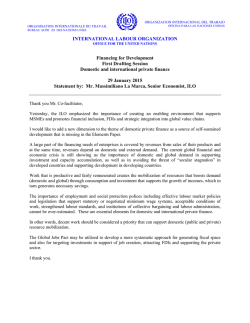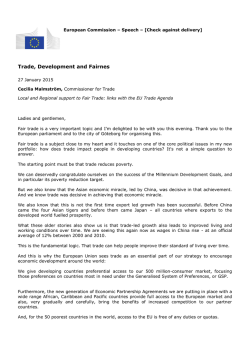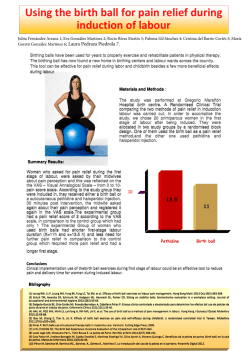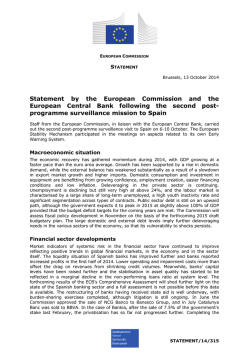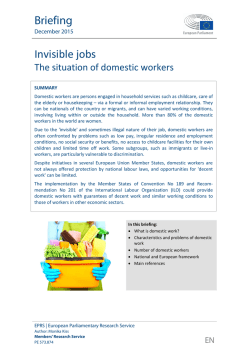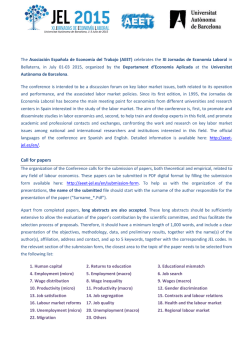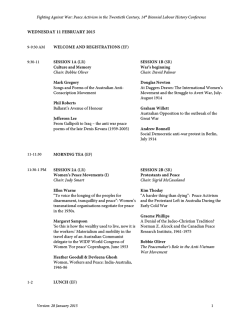
10 million part-time workers in the EU would have
99/2016 - 19 May 2016 Labour Force Survey 2015 10 million part-time workers in the EU would have preferred to work more Two-thirds were women Among the population aged 15 to 74 in the European Union (EU), 220 million were employed, 23 million were unemployed and 136 million were economically inactive in 2015. Around 8 in every 10 persons employed in the EU were working full time and 2 in 10 part-time. Among these 44.7 million persons in the EU working part-time in 2015, 10.0 million were under-employed, meaning they wished to work more hours and were available to do so. This corresponds to more than a fifth (22.4%) of all part-time workers and 4.6% of total employment in the EU in 2015. Two thirds of these underemployed part-time workers were women (66%). Alongside the economically active population (employed and unemployed), 11.4 million economically inactive persons aged 15-74 in the EU had in 2015 a certain attachment to the labour market and could be considered as a potential additional labour force, equivalent to 4.7% of the EU labour force. Among them, around 9.3 million were available to work but not seeking, such as discouraged job seekers, and almost 2.2 million seeking work but not immediately available, for example students seeking a job to start after graduation. The majority of this potential additional labour force in the EU in 2015 was also women (56.7%) This information comes from an article published by Eurostat, the statistical office of the European Union, based on the 2015 detailed results of the European Labour Force Survey. Part-time underemployed & potential additional labour force in the EU, by sex, 2015 Part-time underemployed in the EU Potential additional labour force in the EU Total: 10 million persons Total: 11.4 million persons Males 34% Males 43% Females 66% Females 57% Largest shares of underemployed part-time workers in Greece, Cyprus and Spain In 2015, the proportion of underemployed part-time workers among total part-time workers varied significantly across the EU Member States. A majority of part-time workers aged 15 to 74 wished to work more hours while being available to do so in Greece (71.8%), Cyprus (68.0%) and Spain (54.2%), closely followed by Portugal (46.4%). At the opposite end of the scale, Denmark (9.5%), the Czech Republic (9.6%), Estonia (12.0%), Luxembourg (13.2%), the Netherlands (13.4%) and Germany (14.0%) registered the smallest shares of underemployed part-time workers. At EU level, 22.4% of persons working part-time were underemployed in 2015. It should be noted that underemployed part-time workers were predominantly women in every EU Member State except Romania. Underemployment and part-time work, 2015 Persons aged 15 to 74 working part-time and being underemployed In thousands EU Share of women As % of part time employed As % of total employment Part-time employed aged 15 to 74, in % of total employment 10 005 66% 22.4% 4.6% 20.3% Belgium 169 71% 15.1% 3.7% 24.6% Bulgaria 26 53% 36.7% 0.9% 2.4% Czech Republic 30 70% 9.6% 0.6% 6.1% Denmark 66 64% 9.5% 2.4% 25.4% Germany 1 553 72% 14.0% 3.9% 27.8% 8 67% 12.0% 1.3% 10.8% 111 54% 25.1% 5.7% 22.7% Estonia Ireland Greece 244 54% 71.8% 6.8% 9.4% Spain 1 523 67% 54.2% 8.5% 15.7% France 1 630 73% 33.0% 6.2% 18.8% Croatia 43 51% 39.9% 2.7% 6.8% 748 60% 18.1% 3.3% 18.5% Cyprus 33 55% 68.0% 9.2% 13.6% Latvia 27 65% 37.8% 3.0% 7.9% Lithuania 23 64% 20.7% 1.7% 8.2% Italy Luxembourg 6 75% 13.2% 2.5% 18.6% 68 55% 26.7% 1.6% 6.0% 4 56% 14.9% 2.3% 15.5% Netherlands 563 65% 13.4% 6.8% 50.7% Austria 182 73% 15.7% 4.4% 28.0% Poland 322 63% 27.5% 2.0% 7.3% Portugal 240 63% 46.4% 5.3% 11.5% Romania 268 33% 31.6% 3.1% 9.9% Slovenia 31 64% 32.3% 3.4% 10.6% Slovakia 58 54% 39.7% 2.4% 6.0% Finland 99 62% 26.1% 4.1% 15.5% Sweden 213 65% 17.0% 4.4% 26.0% Hungary Malta United Kingdom 1 718 64% 21.0% 5.6% 26.4% Iceland 10 65% 21.4% 5.2% 24.2% Norway 77 68% 10.8% 2.9% 27.0% 304 74% 17.6% 6.6% 37.8% 15 32% 47.1% 2.1% 4.4% 317 35% 11.1% 1.2% 10.8% Switzerland FYR of Macedonia Turkey The source dataset can be found here. Potential additional labour force by far the largest in Italy The potential additional labour force also varied significantly between Member States, with the largest proportion registered by far in Italy (with more than 3.5 million persons, equivalent to 14.0% of the labour force), ahead of Croatia (9.2%), Luxembourg (7.8%), Finland (7.7%) and Bulgaria (7.1%). It should be noted that in every EU Member State, the potential labour force consisted mainly of persons available to work but not seeking. Women made up the largest part of the total potential additional labour force in a vast majority of EU Member States, with the exceptions of Ireland, Bulgaria, Lithuania, Denmark, Finland, Hungary and Austria. At EU level, the potential additional labour force, made up of 57% women, was equivalent to 4.7% of the total labour force. Potential additional labour force, 2015 Available to work but not seeking Seeking work, but not immediately available Total potential additional labour force In thousands EU Potential additional Share of women in labour force total potential compared with the additional labour labour force aged force (%) 15-74, in % 9 255 2 184 11 440 57% 4.7% Belgium 86 54 139 53% 2.8% Bulgaria 215 23 238 46% 7.1% 49 16 65 57% 1.2% Czech Republic Denmark 44 21 65 47% 2.2% Germany 533 476 1 009 52% 2.4% 28 3 31 56% 4.5% Ireland 23 13 36 45% 1.7% Greece 100 41 141 66% 2.9% Spain 949 220 1 169 65% 5.1% France 674 305 979 53% 3.3% Croatia 162 12 174 56% 9.2% Estonia Italy 3 451 104 3 555 60% 14.0% Cyprus 20 3 22 61% 5.3% Latvia 43 5 49 53% 4.9% Lithuania 13 11 23 46% 1.6% Luxembourg 14 8 22 55% 7.8% 145 9 154 50% 3.4% Hungary Malta 2 : : : : Netherlands 344 156 500 54% 5.6% Austria 161 40 201 50% 4.6% Poland 559 103 662 56% 3.8% Portugal 260 23 283 58% 5.5% Romania 357 : : : : Slovenia 25 (4) 29 (55%) (2.9%) Slovakia 56 14 70 56% 2.5% Finland 141 65 206 48% 7.7% Sweden 123 109 231 51% 4.4% United Kingdom 681 344 1 024 54% 3.1% 8 2 10 56% 5.0% Iceland Norway Switzerland FYR of Macedonia Turkey 72 24 96 47% 3.5% 186 55 241 60% 5.0% : 7 : : : 1 824 62 1 886 58% 6.4% : Data not available or not published due to too small sample size. ( ) Data with reduced reliability due to sample size. The source dataset can be found here. Potential additional labour force in the EU Member States, 2015 (as % of total labour force aged 15-74) 14 12 10 8 6 4 2 0 Geographical information The European Union (EU) includes Belgium, Bulgaria, the Czech Republic, Denmark, Germany, Estonia, Ireland, Greece, Spain, France, Croatia, Italy, Cyprus, Latvia, Lithuania, Luxembourg, Hungary, Malta, the Netherlands, Austria, Poland, Portugal, Romania, Slovenia, Slovakia, Finland, Sweden and the United Kingdom. Methods and definitions The Labour Force Survey (LFS) is a large sample survey among private households. LFS data refer to the resident population and therefore LFS results relate to the persons resident in the country irrespective of the country where those persons work. This difference may be significant in countries with large cross-border flows. For further information, please consult the Eurostat EU-LFS publication. Annual results presented in this news release are calculated as an average of quarterly results. The economically active persons, also called labour force, are those aged 15-74 either employed or unemployed. Conversely, the economically inactive population gathers people aged 15-74 neither employed nor unemployed. Underemployed part-time workers are persons aged 15-74 working part-time who wish to work additional hours and are available to do so. Part-time work is recorded as self-reported by individuals. Persons available to work but not seeking are persons aged 15-74 neither employed nor unemployed who want to work, are available to work in the next 2 weeks but do not seek work. Persons seeking work but not immediately available are those aged 15-74 neither employed nor unemployed who actively sought work during the last 4 weeks but are not available to work in the next 2 weeks. For completeness this category also includes three smaller groups: those who found a job to start in less than 3 months and are not available to work in the next 2 weeks; those who found a job to start in 3 months or more; those who passively sought work during the last 4 weeks and are available to work in the next 2 weeks. Passive job search is e.g. waiting the results of a job interview. Together, persons available to work but not seeking and persons seeking work but not immediately available constitute the potential additional labour force. For more information Eurostat website section dedicated to the EU Labour Force Survey (LFS). Eurostat database on EU-LFS results. Main concepts and definitions of the EU-LFS. Eurostat Statistics Explained article on underemployment and potential additional labour force statistics. Eurostat news release 80/2016 of 26 April 2016 on Europe 2020 employment indicators. Issued by: Eurostat Press Office Production of data: Vincent BOURGEAIS Tel: +352-4301-33 444 [email protected] Havard LIEN Tel: +352-4301-35 226 [email protected] ec.europa.eu/eurostat @EU_Eurostat Media requests: Eurostat media support / Tel: +352-4301-33 408 / [email protected]
© Copyright 2025
